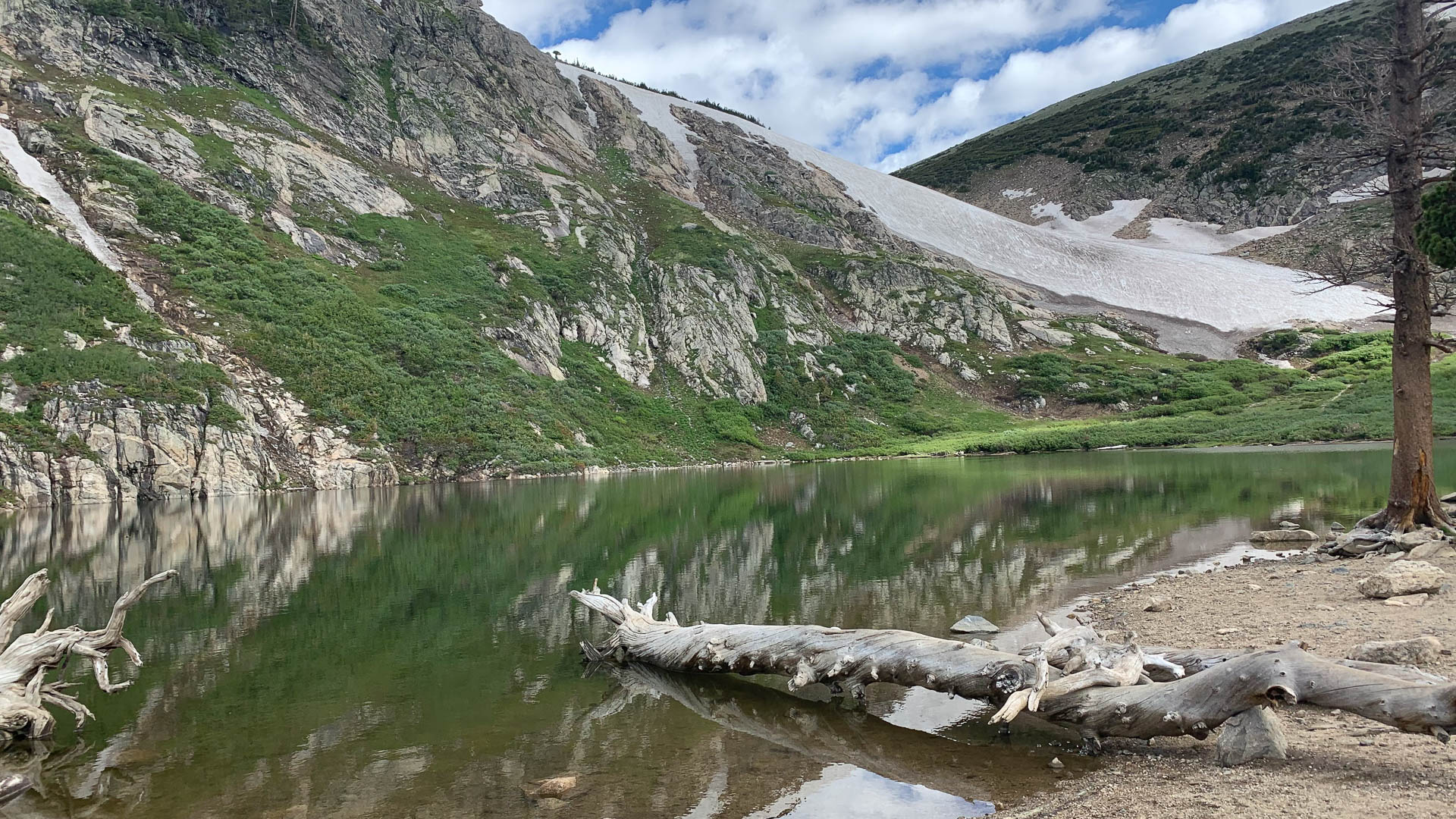
Where you can find snow year-round, you often can find glaciers. Created when more snow falls than melts, glaciers form when that snow turns to ice and is covered by more snow. Most of the glaciers in the U.S. continue to retreat and are shrinking in size due to climate change and other factors. Weather can change quickly in the mountains, so be prepared. Check out current trail conditions as the use of snowshoes, spikes and trekking poles may be necessary. Here are just 10 of the many great glacier hikes you can find in the West.
Blue Lake – North Cascade Mountains, WA
Known as the “American Alps,” the Cascades are home to over 300 glaciers. The hike to Blue Lake is a 4.5-mile-long out-and-back with less than 1,000 feet of elevation gain. The trail begins with several boardwalks and ends with crystal blue water with granite towering overhead. Most of the hike is tree-lined with views of Early Winters Spires, Cutthroat Peak and Liberty Bell. Don’t be surprised to see climbers on the trail. They will most likely cut off at the 1.5-mile mark, where a cairn signals the route to Liberty Bell Mountain. The remains of an old beaver dam can be seen from the trail now sunken into the creek. Cutthroat trout are also common to see along the creek and in Blue Lake. Rocks offer the perfect place for a picnic, while social trails take you along the lake. You can spend some time playing in the snow on this trail from the end of September through summer. Leashed dogs can also enjoy this trail.

Glacier Gorge Trail – Rocky Mountain National Park, CO
Off of Bear Lake Road, the Glacier Gorge Trail is a popular hike in Rocky Mountain National Park as it features just about everything from wildflowers and animals to waterfalls and subalpine lakes. With multiple destinations along one trail, expect for this 5.8-mile loop hike to be busy. If you are up for a longer hike, you can add Andrews Tarn and Andrews Glacier Trail to your hike by taking the Loch Trail after heading back from Glacier Gorge and see an additional glacier. Note that from late May to October 1, reservations are needed on top of paying the daily entrance fee or showing a national parks pass. Make a reservation for your visit with the National Park Service.

Grinnell Glacier – Glacier National Park, MT
This hike takes you to one of the most known glaciers in the U.S. It is also a photographer’s dream hike, taking you past three turquoise mountain lakes. There are two ways to complete this hike: an 11.5-mile total out-and-back starting at the Grinnell Glacier Trailhead, or cut the hike shorter by 3.5 miles by starting at Lake Josephine via a boat ride through the Glacier Park Boat Company. Besides the glacier, this hike is one of the most popular for wildflowers, so expect crowds. Named after George Bird Grinnell, an explorer who was a strong advocate for the creation of Glacier National Park, just above Grinnell Glacier is Gem Glacier. Dogs are not allowed on the trails at Glacier National Park. You must pay the daily entrance fee or show a national parks pass.

Harding Icefield Trail (Exit Glacier) – Kenai Fjords National Park, AK
Leaving from the Exit Glacier area, the 8.2-mile Harding Icefield Trail is a strenuous hike, climbing 3,500-plus feet to above the treeline. The ice field stretches for 700 square miles. The trail features two popular stops along the way: Marmot Meadows at around 1.5 miles and Top of the Cliff at 2.5 miles. Throughout the trail, animals such as mountain goats, bears and marmots are often seen. Heather meadows make the summer views extra special. The trail is covered by snow year-round, so check local conditions and trail beta (information about the trail provided by someone who has recently completed it) to see what special equipment may be needed. For a shorter route that passes the Harding Icefield, consider the Exit Glacier Trail — a 2.2-mile excursion that takes you to Exit Glacier. Dogs are not allowed on the trails at Kenai Fjords National Park. You must pay the daily entrance fee or show a national parks pass.

Mendenhall Glacier – Juneau, AK
For a unique glacier experience, consider a visit to the Mendenhall Glacier. For an up-close experience, consider a private tour with an outfitter along the West Glacier Trail for a 7-mile round trip. It only climbs 800 feet, but the trail is covered in ice, uneven and steep in places. The trail takes you through the Tongass National Forest — the largest temperate rainforest in the world. The Photo Point Trail is an easier, paved, 0.6-mile trail that takes you to panoramic viewing areas for photos. You can add on the Nugget Falls Trail for a total distance of 2.1 miles with a view of the falls and the Mendenhall Glacier.
Mt. Timpanogos/Timpanogos Glacier – American Fork, UT
While there is debate whether the snow that never melts on top of Mt. Timpanogos can be called glacial, Timpanogos Glacier is mentioned in many guidebooks and websites. Geologists call it a rock glacier because it is covered with rocky debris cemented by ice. You can hike the trail starting from either the Timpooneke Trailhead or the Aspen Grove Trailhead. Both require a $6 day-use fee for American Fork Canyon. The trail is 14.5 miles round trip from the Timpooneke Trailhead or 13.5 miles from Aspen Grove. This hike is strenuous from either trailhead, with 4,500-plus feet of elevation gain. Moose, mountain goats and wildflowers are abundant along either route you choose to take. Fall color also makes this a popular trail. Leashed dogs can summit this 11,749-foot peak.

Root Glacier Trail – Wrangell-St. Elias National Park and Preserve, AK
From the Kennecott Visitors Center, the Root Glacier Trail is a moderate 3-mile trail that travels past both the Kennecott and Root glaciers. Along the trail, you can get an up-close look at the Stairway Icefall that spills 6,000 feet off Regal Mountain. Many visitors say you can hear glacial features on top of seeing the glaciers. Bears are also frequently sighted along the trail. If you are up for a longer trek, it is an 8-mile hike out to the Erie Mine tram cables and back. It’s an additional 1.5 miles each way with steep slopes and requires strong navigational skills. You must pay the daily entrance fee or show a national parks pass. Dogs are not allowed on the trails at Wrangell-St. Elias National Park and Preserve.

Skyline Trail – Mt. Rainier National Park, WA
Beginning at the Jackson Visitor Center at Paradise, the Skyline Trail is a 5.5-mile trail with around 1,700 feet of elevation gain. Wandering through a subalpine forest, it is suggested to hike the loop clockwise to Panorama Point to the High Skyline Trail. Connect back to the Skyline Trail and head on to Paradise Glacier Trail for a chance to see Mt. Rainier and the Nisqually Glacier up-close. Wildflowers and, on clear days, views of Mt. Hood just add to the beauty of this trail. This trail offers incredible views at sunrise and sunset. Off-peak times offer the best chance to beat the crowds. Since this glacial trail is in a national park, your pooch is not allowed on the trail. Pay the daily entrance fee or show a national parks pass.

St. Mary’s Glacier – Idaho Springs, CO
Home to the now-defunct St. Mary’s Ski Area that was open from the 1930s to 1986, the hike to St. Mary’s Glacier is approximately 2.5 miles out and back. You can add or subtract round-trip mileage depending on whether you hike up to James Peak or how high you go on the glacier. The trail is rocky most of the way and can be washed out if there have been recent rains. A side trail on the right at 0.3 miles takes you to a cascading waterfall and is worth the small side trip. Don’t be surprised to see skiers or snowboarders hoofing it up or skiing down the glacier. Snow can be found on the glacier year-round. Parking is limited and crowded both on weekdays and weekends. Bring $5 cash for parking and a pen to fill out the envelope. Leashed pups can also enjoy some playtime in the snow.

Wheeler Peak Glacier – Great Basin National Park, NV
While it may be hard to believe, there is actually a 2-acre glacier in Nevada: the Wheeler Peak Glacier, said to be left over from the first ice age. The hike to the Wheeler Peak Glacier can be done two ways. If you want to summit the peak, the trail starts at the campground. The trail is 8.5 miles with almost 3,000 feet of elevation gain and quite rocky. For a shorter hike, begin on the Bristlecone Trail and move on to the Glacier Trail. The Glacier Trail will take you to the Wheeler Peak Glacier. Round trip, this hike is 4.5 miles long with 1,100 feet of elevation gain. Don’t miss the interpretive signs along the Bristlecone Trail that tell-all about the ancient trees that line the trail. Since this glacial trail is in a national park, your pooch is not allowed on the trail. Pay the daily entrance fee or show a national parks pass.






